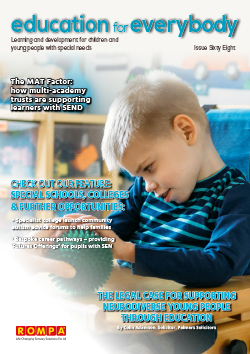When was the last time you read a book that featured a dynamic character with a disability? How many plot lines can you recall in which ‘having a disability’ was not the primary focus of a character’s story?
The reality is, there’s little out there showing children with disabilities in a strong, positive light; full of action and adventure; with characters who get into mischief, explore, dream, misbehave and show the strength and confidence we want to inspire in all children and young people across the country.

When my daughter Emily, who uses a wheelchair, was at school, she used to get so frustrated, she found no characters in books that she could relate to. No narratives that aligned with her experiences. As an author and as an illustrator, I felt it was time things changed.
Inclusion is not a delusion – that’s my motto, and it’s what informs my work every day. A few years ago, I created a series of books around five superheroes with disabilities. Just like any other superhero stories, they all had a special power and got involved in some great adventures, it just happened to be that these superheroes all had a disability. Daredevil is blind, Professor X is paraplegic, Pawsy has a hi-tech running blade, Claypole uses a white cane and Brook uses a wheelchair. None the less, they were still able to save the day.
Importantly, both to me and society as a whole, is that these stories don’t infantilise or explain disabilities to readers too clinically but instead, provide the opportunity to bridge the gap between children with additional needs and their peers.
When Pearson approached me to write a cluster of books for their Bug Club range, I was delighted. I jumped at the chance of writing more stories that all children, including those with disabilities, can relate to and engage with. Stories where characters with disabilities are centre stage.
This particular cluster of books focuses on Brook, a young girl who uses a wheelchair and is very proud of her disability, and indeed, empowered by it. Her confidence and determination take her on a world of adventures, fulfilling the dreams, aspirations and goals that she and many other children today have.
In the first book, Brook finds herself travelling to the moon. In the second, she enters a time machine, encountering a range of inspiring people from the past who have disabilities, and in the third book, Brook meets children who are new to using a wheelchair. I wanted this particular story to focus on the transition some children go through to help them understand that it doesn’t have to be scary. Brook teaches them how much they can still do. Playing football, swimming, playing with their friends who are on skateboards and more! It’s all possible.
It’s important that as readers, we understand the experiences of all children and appreciate that despite their difficulties, they can push the boundaries, they can – and perhaps more importantly – will achieve.
Walking down a street and seeing a child with a disability, whether they are in a wheelchair, unable to walk in the same way, or even sound or look the same, will always be fascinating to some children, but by sharing stories and adventures like Brook, we have a chance to broaden understanding and acceptance. We need more positive texts – picture books, written stories, poetry and more – where characters with disabilities shine through, because all children, whatever their background or ability, have a right to feel represented.
Dan White is the author of the new children’s book cluster ‘Look, Brook’, part of Pearson’s Bug Club collection for primary readers.
To explore the full Bug Club range, visit https://bit.ly/3TV2krT






